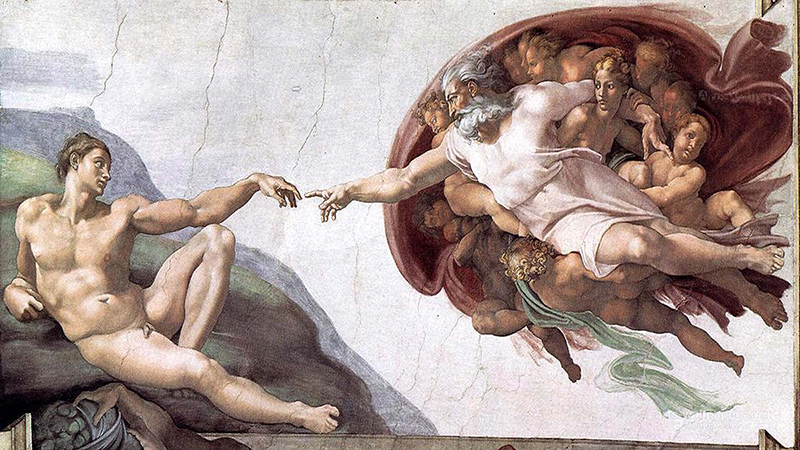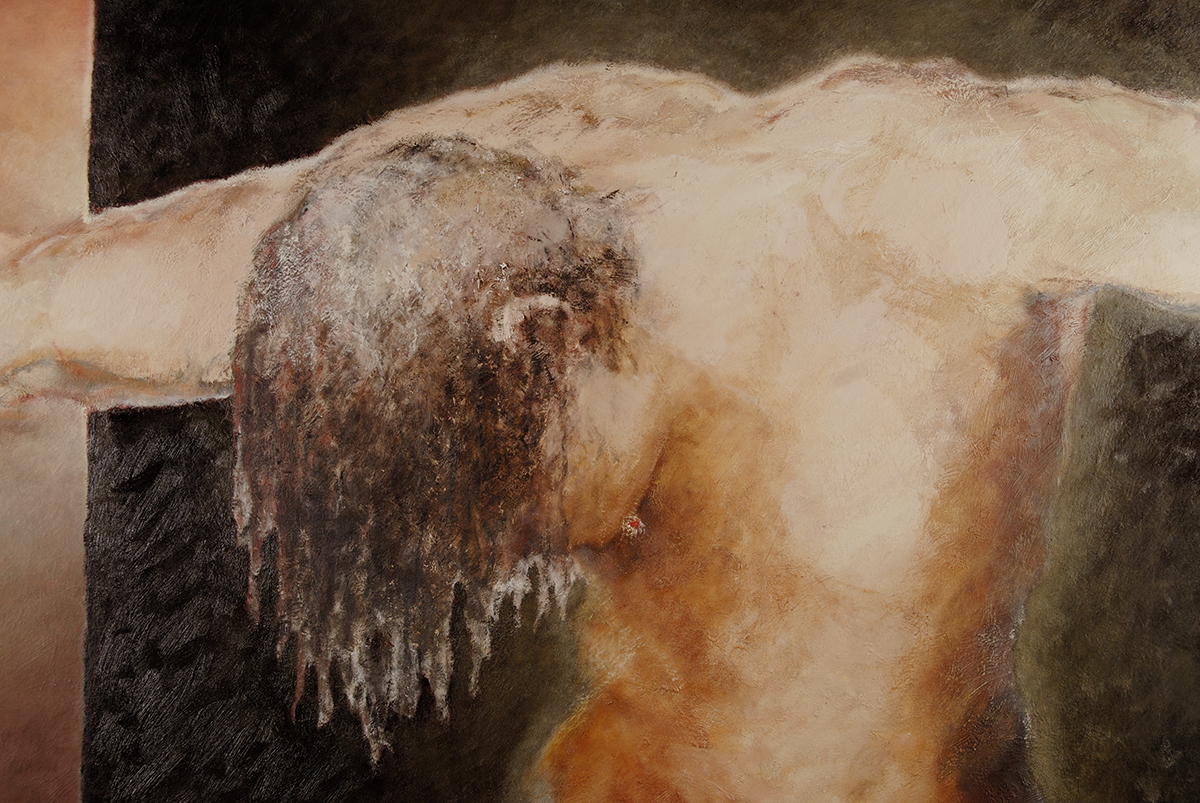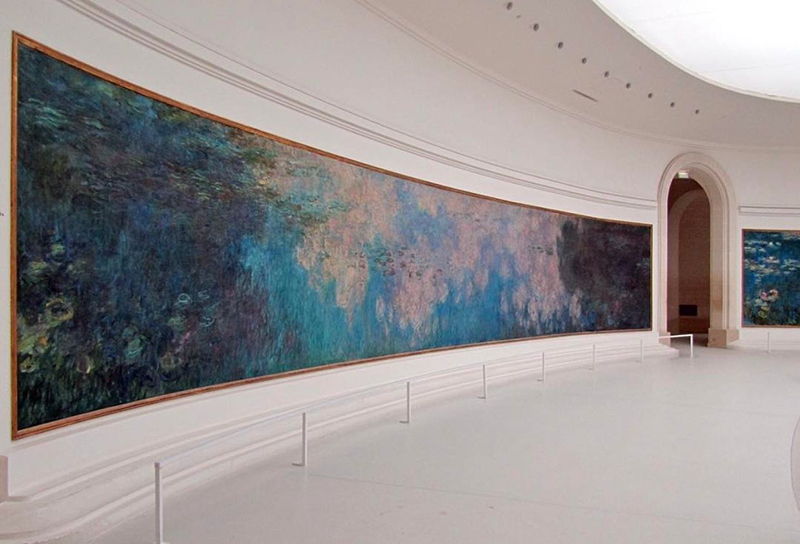Back to writings
Even the spaces were defined as simple as possible and linked to the place in which they were to be hung. I wanted a compact gesture. The models used for the different people were friends, family and others. The most peculiar was that I took Gala as the model for the young Jesus in the ‘Madonna and Child’.
Back to writings
THE WORKS FOR THE CHURCH GESÙ REDENTORE, MODENA, ITALY.
THE COMPITITION WON.
It must have been in 2002. I was on a bus when Mauro called me with the message that we had won. He told me that I had to make the paintings for a new church in Modena. There was time, so I took the news calmly.
Mauro had used images of my paintings for the competition for a church without my knowing.
I came to Milan to make more adequate sketches. To be made were:
-
A Crucifix of about 300 x 250 cm.
-
A Madonna with child of 480 x 300 cm.
-
A Pieta of about 300 x 1100 cm.
-
A Via Crucis consisting of a series of 14 silkscreen prints on glass over a wall of 600 x 2000 cm.
I could only make sketches for the first three works. The Via Crucis would be given another twist, so I could not work on that theme.
sketches of the three to be made paintings.
THE PRESENTATION IN MILAN, MODENA AND ROME IN 2005.
Presentation of the church.
Not much after the presentation I met the priest, don Marco Pongiluppi. We discussed the new proposals.
The financing had to be organized still. In the meantime I met and convinced the parish and the Curia.
Don Marco and I went to Rome to persuade a priest of the Commitee of Fine Arts of the Vatican. We went to one of the many Baroque churches and through a small door in the back of the church we entered a studio, where a priest was hacking away in a chunk of wood. He reacted enthusiastic when he saw the sketches and was even more when he heard that I wanted to see the portrait of pope Innocenzo X with Don Marco.
After our visit to the museum we ate a scary bad pizza and rounded it off with a granita di caffé con la panna in ‘La Tazza d’Oro’. That balanced out the pizza. Mission completed.
Pope Innocenzo X, (Velàzquez -Galleria Doria Pamphilj, Rome), granite di caffé con la panna, La Tazza d'Oro.
In 2006, just before Gala was born, the financing was organized. Once again the news came to me on my mobile phone. I was buying a pram. So this time not in a bus, but in a shop… In Catalonia people often say a child is born with a loaf of bread under the arm, this time it was true.
I was present when they laid the first stone and was paid one third in advance so I could start.
IN 2006 THE PAINTING STARTS.
I limit myself to explain about the meaning and style, for the process see the link to the documentary below.
ABOUT THE PEOPLE ON THE CANVASSES.
A very important choice was to be made about how to dress the people. My idea was not to make historical paintings. I did not desire an exotic or antique atmosphere. The message had to be universal and of all time. I chose for a simple as possible clothing, actually nothing more than just pieces of cloth. If Mary would wear blue jeans, it would give too much a culture and time defined image. It would lead away from the continence that had to be shown.
Even the spaces were defined as simple as possible and linked to the place in which they were to be hung. I wanted a compact gesture. The models used for the different people were friends, family and others. The most peculiar was that I took Gala as the model for the young Jesus in the ‘Madonna and Child’.
THE CRUCIFIX.
Jeanluis, an ex dancer, was the model for the adult Jesus. I painted him on the cross with the villains on both sides.
Don Marco asked for this. The crucifix was not to give a sad message. I chose the moment of dying. I painted Jesus as if in this moment he dissolves in the All. On the left there is the villain who wanted to be saved and was, hence the vertical striping, on the right the villain who refused. There the stripes are like scratches. For the right one I took myself as the model. As colour scheme I used the red of the wall of the church.
Crucifix, in the space and me working on it
Click on one of the images to go to the ‘Crucifix’ on the site.
MADONNA AND CHILD.
For these two I chose Rosa and Gala. The Madonna is seated on a throne that cites the pulpit, situated on the same side of the church.
I encountered a practical problem: the painting had to be high 480 cm, whereas my studio was only 410 cm high. I solved it by cutting the image in three. This gave two irritating horizontal lines. In the bottom and top part of the work I painted water. This connects the work to the water that streams behind the wall and can be seen through a window under the triptych. As if the ‘river’ that flows behind the work creeps up through the painting.
On the middle piece I painted a series of portraits behind the Madonna and Child, thus creating a horizontal and vertical pattern. This camouflaged the two horizontal lines.
I did not paint angels behind the two, but the people for whom Jesus had come to earth and die for. As characters I chose friends, people from the parish and two criminals. One of them came to visit the studio; of the other the photos were taken in the prison of Modena. He had been there for already 20 years. ‘The first will be the last…’
Under the dress of Mary you see a head. In the old days in the northern countries children hid under the dress of their mother for warmth.
As said, the colours and shape of the throne refer to the pulpit. Mary is dressed in red and blue. Jesus stands on her knee, ready to go out into the world to save.
Madonna and Child, in interior and me working on it.
Click on an image above to go to ‘Madonna and Child’ on the site.
THE PIETA.
The Pieta is a triptych as well. And here too Don Marco wanted a positive message. To make this possible I came up with the idea not to have Jesus on the lap of Mary. The moment just before is shown. In the middle canvas the dead Jesus sits in the crucifix position. The colours of the background are as the actual situation (here and now). The ground surface is green-grey, like the floor in the chapel. The wall behind has the same stone red colour of the walls of the church. In the canvasses on both sides the colours are reversed. Because Jesus is the main character I painted him bigger in size than the others. This was often done in the Romanic and Gothic paintings. And like this he 'enters the chapel'. He is the only person who reaches out of his canvas into another.
By choosing the moment just before Mary takes him in her arms, I could come with the positive switch. Mary walks with her arms open towards Jesus. Jesus’ right hand reaches out to her womb.
There are two crucial moments in Christianity. The first is the creation of the All. In the final moment God gives life to mankind. This is represented on the ceiling of the Sistine Chapel by Michelangelo.
The Sistine Chapel: Adam created by God, Michelangelo, Rome.
In my Pieta Jesus makes a similar gesture; he blesses the womb of the pregnant Mary.
Mary is the mother of God and thus the mother of all Christians. Because Jesus has not resurrected, Christianity is not ‘born’ yet, it is still in the pregnant phase.
Mary as earthly mother is with her face in the shade, mourning over the death of her son. Her womb receives the light.
On the panel on the right there are 4 people. First one is Saint John, the evangelist of the light and dark, hence he has one foot in the light, the other in the shadow. He carries the Grail in which Jesus’ blood was caught. Behind him in the dark are Nicodemus and Joseph of Arimathea. They assisted at the funeral, but did not get out into the open, being afraid of repercussions. Joseph is holding the Shroud and is only concerned about the funeral. Nicodemus holds the myrrh and looks afraid at the public, hoping not to be seen. Through him you can ‘enter’ the triptych. The last person on the right is Mary Magdalene. She was the first to discover the arisen Jesus. And she did come out into the open about her belief. That is why she too receives light. The two women 'embrace' the scene.
The Pieta, in the space and me working on it.
Click on one of the images to go to the ‘Pieta’ on the site.
The people I used for the different characters were Rosa, Jeanluis, a former priest and three acquaintances from Barcelona.
Light plays a major role.
THE WOUND.
A special detail is the wound in the side of Jesus. Time ago a friend told me that a painting should contain a ‘mistake’, a bump over which you stumble, so the work remains longer in your thoughts, because something irritates.
This triptych is about human suffering, so I ‘pierced’ the side of Jesus. On the spot where he was pierced I first painted red that later I covered with the body colour. Once dry, I delicately cut away the top layer. It looks as if the painting is wounded.
The wound.
During the working process I met the architect in Paris. We went to the ‘Orangerie’ and there he indicated, that the real spaces are the paintings and not the room they are in. This was clearly a request to make the image so strong that it pushed the real space away.
Orangerie, Monet, Paris.
THE VIA CHARITATIS.
As last I made the series of silkscreen prints for the Via Crucis, here transformed to the Via Charitatis.
In the building there are a series of apartments situated in which people who have problems can live for a period and get their lives together again. That is why instead of showing the different stages to the cross, this 'Via' shows a story about charity.
The composition of the 14 images and the sizes were decided by the architect. The colours used for the prints were charcoal black and drawing chalk red, like the colour of the inside walls of the church.
Silkscreen prints on glass in the inside garden and some preparatory sketches.
Click on the images to go to the ‘Via Charitatis’ on the site.
The church was initiated in May, 2008.
Gesù Redentore, Modena, Italy.
I feel honoured to have been asked to participate in this project.
For the ones who like architecture, click on the images above to go to the site of the architect Mauro Galantino.
From the start of the painting period till the initiation of the church Carlos Hernandez filmed the process. In the end he had 60 hours of material. He was unable to cut it to a documentary. I tried to help him much, but to no avail. Now (2019) Map and Harry Baggen made the documentary. I thank them too for the work they put into it.
Click on the word: 'Gesù Redentore' to go to the documentary.
Barcelona, 2019.










